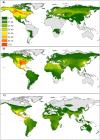Light pollution is greatest within migration passage areas for nocturnally-migrating birds around the world
- PMID: 29459760
- PMCID: PMC5818656
- DOI: 10.1038/s41598-018-21577-6
Light pollution is greatest within migration passage areas for nocturnally-migrating birds around the world
Erratum in
-
Author Correction: Light pollution is greatest within migration passage areas for nocturnally-migrating birds around the world.Sci Rep. 2018 Mar 14;8(1):4799. doi: 10.1038/s41598-018-23089-9. Sci Rep. 2018. PMID: 29540780 Free PMC article.
Abstract
Excessive or misdirected artificial light at night (ALAN) produces light pollution that influences several aspects of the biology and ecology of birds, including disruption of circadian rhythms and disorientation during flight. Many migrating birds traverse large expanses of land twice every year at night when ALAN illuminates the sky. Considering the extensive and increasing encroachment of light pollution around the world, we evaluated the association of the annual mean ALAN intensity over land within the geographic ranges of 298 nocturnally migrating bird species with five factors: phase of annual cycle, mean distance between breeding and non-breeding ranges, range size, global hemisphere of range, and IUCN category of conservation concern. Light pollution within geographic ranges was relatively greater during the migration season, for shorter-distance migrants, for species with smaller ranges, and for species in the western hemisphere. Our results suggest that migratory birds may be subject to the effects of light pollution particularly during migration, the most critical stage in their annual cycle. We hope these results will spur further research on how light pollution affects not only migrating birds, but also other highly mobile animals throughout their annual cycle.
Conflict of interest statement
The authors declare no competing interests.
Figures




Comment in
-
Satellite megaclusters could fox night-time migrations.Nature. 2020 Oct;586(7831):674. doi: 10.1038/d41586-020-03007-8. Nature. 2020. PMID: 33110255 No abstract available.
References
-
- Newton I. Can conditions experienced during migration limit the population levels of birds? J. Ornithol. 2006;147:146–166. doi: 10.1007/s10336-006-0058-4. - DOI
-
- Cohen EB, et al. How do en route events around the Gulf of Mexico influence migratory landbird populations? The Condor. 2017;119:327–343. doi: 10.1650/CONDOR-17-20.1. - DOI
Publication types
MeSH terms
LinkOut - more resources
Full Text Sources
Other Literature Sources

